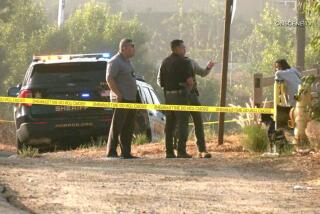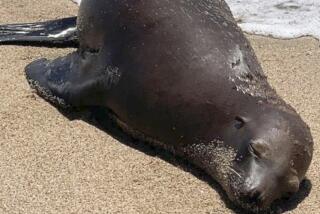Man killed by shark in Santa Barbara County
- Share via
A 39-year-old man surfing off the Santa Barbara County coast was killed Tuesday in a shark attack that occurred off the same beach where a bodyboarder was killed two years ago.
Francisco Javier Solorio Jr. of nearby Orcutt was dragged by a friend onto the beach after he suffered a massive bite on his upper torso that turned the water around him red, Santa Barbara County sheriff’s officials said. He died at the scene.
“His friend saw the shark bite him,” said Sgt. Mark Williams. “It was a pretty bad bite.”
Solorio’s surfboard also had bite marks on it, said Lt. Erik Raney. The Santa Barbara County coroner’s office is expected to consult with a shark bite expert to examine both Solorio’s wounds and the marks on the board.
The attack occurred amid light winds and 1- to 2-foot waves shortly before 11 a.m. off Surf Beach. The beach runs along the edge of Vandenberg Air Force Base but is a popular spot with local swimmers and surfers.
Authorities ordered beaches along the Vandenberg coast closed for 72 hours as officials try to determine the level of danger to public.
Officials said they are still trying to officially ascertain what kind of shark was responsible for the attack. One expert, however, said it had all the hallmarks of a great white.
“There is no other species swimming off of the coast regularly that could possibly do that kind of damage,” said Andrew Nosal of the Scripps Institute of Oceanography in La Jolla. He added that great whites are responsible for almost all shark attacks off the California coast.
Solorio’s friends told local TV stations in Santa Barbara County that Solorio had been surfing in the local waters since he was a boy.
“He was a really good surfer,” Nathan Winkles told KEYT-TV.
Solorio’s death marks the 13th fatal shark attack in California waters since 1950. Five of those have occurred since 2003.
On Oct. 22, 2010, Lucas Ransom and his friend were bodyboarding when a shark appeared and pulled the 19-year-old under, ripping his left leg off at the pelvis.
Ransom’s surfing buddy Matthew Garcia told The Times that the shark was 18 to 20 feet long and that the attack was stealthy and sudden.
“It was all really quick.... Imagine a river of blood. That’s what the wave looked like for a minute,” Garcia said. “You would have never known there was a shark in the water.”
Shark attacks declined in the United States last year, but worldwide fatalities doubled, according to a report released earlier this year.
Of the 75 shark attacks around the globe in 2011, a dozen were fatal, up from six the year before, according to the annual report by the International Shark Attack File, which is compiled by the Florida Museum of Natural History at the University of Florida.
Despite the publicity that comes with shark attacks, they are extremely rare, said Nosal of the Scripps Institute.
He said that the documented increase in shark attacks is largely due to higher volumes of people using the water for surfing and body boarding, and not because of an increase in the number of sharks.
“The population off of California is rather small,” Nosal said, adding that the most recent survey placed the state’s great white shark population at around 300. “The fact that people are reporting more shark sightings is due in large part to there being an increase in awareness.”
But Peter Howorth, director of the Santa Barbara Marine Mammal Center, said there appears to be an uptick in the number of shark-related attacks on people and marine mammals in recent years in California. And he is skeptical of studies that suggest the shark population is declining.
A state ban on gill nets and a prohibition against “the taking of great whites” has led to an increase in the numbers of sharks, including species that prey on large marine mammals, he said.
[email protected][email protected]
More to Read
Sign up for Essential California
The most important California stories and recommendations in your inbox every morning.
You may occasionally receive promotional content from the Los Angeles Times.










